
 When I was a kid, one of my favorite board games was Mars 2020 in which players compete to get their space program to the Red Planet first. There’s always been a mystique around the year 2020, and now that I’m writing about boat tech in 2018, I find myself thinking about the state of boating technology of today and in the near future.
When I was a kid, one of my favorite board games was Mars 2020 in which players compete to get their space program to the Red Planet first. There’s always been a mystique around the year 2020, and now that I’m writing about boat tech in 2018, I find myself thinking about the state of boating technology of today and in the near future.
From revolutions in solid state semiconductors for radar, 3-D forward facing sonar, remote vessel monitoring systems, the prospect of 100 percent planetary satellite coverage, all the things one can do with a smart device, and more, boating today can resemble a Mars mission in more ways than one.
Here we look at some of the techy treats and trends defining boating in 2018. By no means a complete summary, these are just a relative handful of all the futuristic offerings already here or soon available.
Word of caution: remember to own the tech, not be owned by it. We will always need skilled skippers at the helm.
The consensus from the modern radar manufacturer community is that the venerable cavity magnetron technology is officially on the outs in favor of silicon carbide semiconductors.
Cavity magnetrons were critical during the WWII era to make radar work aboard. The essential premise is that a high-powered vacuum tube generates microwaves via a stream of electrons interacting with a magnetic field moving past a series of open metal cavities (cavity resonators).
Solid state silicon carbide semiconductors came onto the marine radar scene in the early 2000s and have been chipping away at cavity magnetron’s dominance. The advantages of solid state semiconductors are wideband capabilities, instant activation, longer lifespan, lower power consumption, lighter weight, and a more compact design. While companies are still making cavity magnetron radars for both the commercial and recreational spheres– with Furuno even introducing a new line of magnetron radars (“X-band” series)–cavity magnetron is definitely on the run from solid state.
Boaters should expect even more capable radars in the coming years thanks to the general superiority of solid state units. In the meanwhile, be sure to give cavity magnetron units you come across a well-earned salute. We’ll never know how many mariners’ lives and vessels the technology has saved.
The innovations around sonar are happening at an ever-increasing pace, and at this point it feels almost as if engineers are pulling off miracles based on bold inter-company dares.
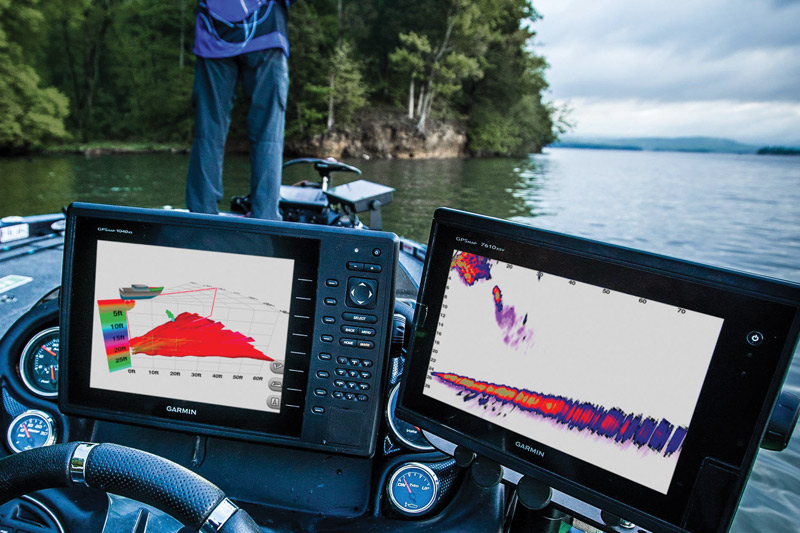
below in the field. Why look down when you can look ahead?
Take forward looking sonar, for example. Forward looking units direct a narrow acoustic beam forward to see what’s coming, not just what’s underneath. Companies like Simrad with their ForwardScan and EchoPilot’s forward looking sonar units have done well with two-dimensional imaging for the last few years. Garmin’s recent introduction of the Panoptix sonar unit allows you to see what’s coming in all three dimensions.
Just about every parameter of beam manipulation is constantly being pushed to the next level with no plateau in sight.
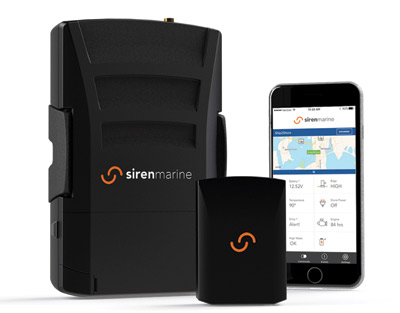
There has been a flurry of innovation around the vessel monitoring scene within the last year or two. Companies like Siren Marine now make compact, non-invasively installed sensors that can monitor boat position, battery voltage, engine metrics, bilge pump activity, temperature, and even motion for security purposes. This information is fed to the owner’s smart device remotely, essentially acting as a permanent first mate aboard when you’re away.
Innovations in this field will likely include more ways to physically control the boat from a distance as well. For example, if one is monitoring moisture during a wet Pacific Northwest winter, perhaps he or she could remotely turn on the dehumidifier from home with a touch of the screen? We’re not far from that reality being commonplace.
It would be impossible to write about boating technology and not mention the rise of the smart device as a tool on board. The vast potential is obvious, as there is an app for just about everything from weather to navigation. The smart device will likely continue to become an even more prominent presence aboard in years to come.
However, there are limitations of smart device technology. Take navigation as a case study. A modern GPS chartplotter will utilize a proper 10-hertz receiver to get an accurate coordinate fix, but no 2018 smart phone has that kind of capability with its GPS locator. The key to maximize the smart device in this instance is to pair it with an on-board GPS receiver, sold for around $100. The receiver is unobtrusively mounted somewhere aboard, and the wireless technology transmits that GPS data directly into the smart device that acts as a handheld display screen.
The pair and play strategy is a clever one that addresses the on-average less powerful capabilities of smart devices that by themselves are a jack of all traits, master of none when it comes to roles aboard.
One great example of how a smart device can fill a niche aboard is the CrewWatcher, a crew overboard alarm device and app combo that hit the market last year. The CrewWatcher is housed in a waterproof plastic casing that’s easily worn. The device is in constant wireless communication with a linked onboard smart device, and unless somebody goes over, will go unnoticed during the boat trip.
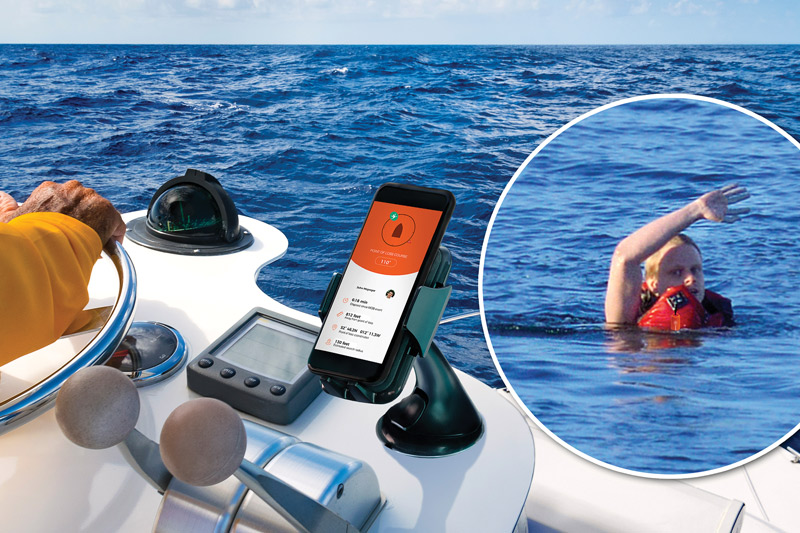
If somebody does go over, the wireless connection is broken and the app automatically triggers a man overboard alarm.
Not only does it make a loud noise to alert the skipper, but the last known coordinates (presumably the location where the person went over) are also displayed. A handy display of the bearing to the overboard coordinates and distance to the point are also displayed, so the skipper can easily drive the boat in the right direction. Overall, it’s a simple, ingenious use of the smart device that costs around $90.
The promise of Low Earth Orbit (LEO) satellites, largely considered the most practical way to cover 100% of the planet, is captivating the communications industry. The idea is to blanket Earth in a swarm of small LEO satellites, which are different than the current far-orbit geo-synchronous Earth orbit (GEO) and medium-Earth orbit (MEO) satellites that have made up the backbone of communications since the 1960s.
The autonomous technology of land and sky with aerial drones is finding its way onto the water. One such example is the new SOLO personal watercraft, a remotely-controlled, high-powered aquatic drone boat that is designed to pull a tech savvy water skier/wakeboarder.
The sporty fiberglass craft is 675 pounds and propelled by a 150-horsepower three-cylinder, four-stroke Rotax inboard gas engine. The user controls the craft via wireless technology, and the SOLO cuts the engine automatically when it runs more than 40’ feet from the operator. It can even be summoned to the operator at idle if commanded to do so. More info is available at solowatersports.com.
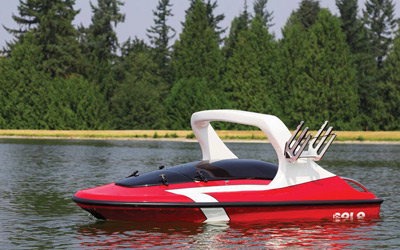
The consequence for this LEO effort is that cellular, internet, etc. coverage will probably become a reality farther and farther from shore. Redmond, Washington-based Kymeta Corp. has made a new flat-panel satellite antenna that does away with the dish design we’re familiar with. This antenna is built to integrate with the current GEO and MEO systems, as well as the LEO one that is in the works.
Although there are not nearly enough LEO satellites to fulfill the dream of planetary coverage now, it’s definitely possible within the decade.
Electricity takes a more central role aboard these days, largely thanks to continuous improvement of batteries and battery banks. While lead acid remains the most common battery type, improvements within the lead acid family are making leapfrog advances.
Within the lead acid family, absorbent glass mat batteries (AGMs) are replacing the distilled water of old-school lead acid batteries with maintenance-free solid, conductive fiberglass material. These AGM batteries store substantially more electricity for their weight than their wet lead acid counterparts and are priced well at a few hundred dollars more per unit.
Within the last year or so, the fiberglass in some AGM batteries has been replaced with carbon foam (notably the Firefly Energy Oasis Microcell™ Carbon Foam line). The carbon foam is more resistant to sulfation, the crystallization of lead sulfate often brought on from frequent intense energy draws of lead acid batteries. Sulfation is the leading cause of death for traditional lead acid batteries. Thanks to the sulfation resistance, a user can draw from a carbon foam battery more aggressively, even down to near-zero, without consequence.
Innovations with regards to hull design have been a hallmark of the marine sphere since the prehistoric beginning of boats. It’s a given that hull designs from the recreational to the commercial will continue to be tweaked and evolve with time, and it seems inevitable that hull forms will also become higher performing and more specialized.
One such example is the recently unveiled AC75 concept for the upcoming 36th America’s Cup (2021). The fully foiling monohull from Emirates Team New Zealand and Luna Rossa design teams features highly adjustable twin canting T-foils. The AC75 will adjust these twin foils dependent upon the situation to do anything from taking, increasing stability, docking, or righting itself from a capsize.
Remember in “Star Wars: A New Hope” when the Rebels in their X-wing starfighters “lock S-foils in attack positions” before attacking the death star? It’s kind of like that. Check it out at americascup.com.
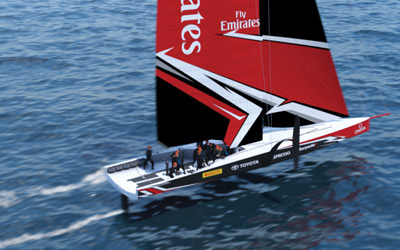
Lithium ion batteries also make sporadic appearances aboard these days, but they are largely considered cost prohibitive and have some quirks that haven’t translated perfectly from land to sea yet. One such quirk is that overcharging lithium ion batteries is not a benign process, and they can overheat and even explode. Having a smart charging system goes a long way to prevent this, but boaters will have a steeper learning curve with these than more common and affordable AGMs.
The previously mentioned smart chargers are also a landmark of boating technology evolution and should continue to improve in the coming years. Every kind of battery has its idiosyncrasies when it comes to charging up, and smart chargers are programmable to the proper sequence to match one’s batteries. The modern combination of a smart charger and a carbon foam AGM battery bank is about as sweet as it gets in 2018. Throw into the mix a monitoring system that talks to your smart phone (or watch), and you’re on your way to be a posterchild for the 21st century boater.
Advances in electrical technology are also prompting more manufacturers to take a stab at all-electric and electric hybrid propulsion technology. A notable company in this field is the German-based Torqeedo. Mostly known for their all-electric outboards, they have developed the Deep Blue Hybrid technology that combines large battery banks and a high voltage diesel generator to convert sailboats 40′ to 80′ into aquatic Priuses. While this technology is still taking its baby steps, it’s not inconceivable that the concept becomes more and more feasible as batteries get smaller and more powerful.
The automatic identification system (AIS) that tracks vessels by constantly relaying vessels’ positions is not new technology, but the AIS device market is getting more compact and user-friendly. Large commercial vessels, forced to do so out of legal compliance, have utilized AIS for years but the systems were not
necessarily geared toward small recreational craft.
One such example is the SmartFind G8 AIS and Kannad SafePro AIS EPIRBs from the McMurdo Group that hit the market last year. These are the first to integrate a handheld EPIRB (Emergency Position Indicating Radio Beacon, activates an international satellite search and rescue system) with an AIS. With AIS devices that now fit in the palm of a hand, the safety of AIS is much easier to tap into.
AIS is only as good as the number of boaters who use it, and in this regard, boating Americans have traditionally been less enamored with the tech than their European counterparts. However, that trend appears to be changing as more Americans hop onto the AIS bandwagon with more convenient devices. Expect more casual AIS use among American recreational boaters in the years to come.